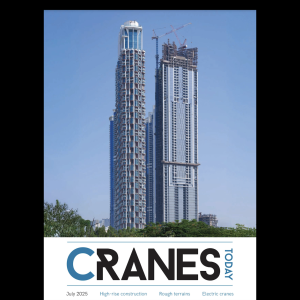?The first Iron Fairy two-axle rough terrain pick and carry cranes were launched in 1956 by British Hoist and Crane, and the cranes sold in their thousands for industrial and port use in the UK and around the world for four decades. An Iron Fairy graced the first cover of Cranes Today in 1972, reprinted in April 2008. But recession in the early 1990s forced the Jones plant to shut production in 1994.
The company’s cranes and spare parts were scattered around the market in the mid-1990s. The Jones Cranes company was revived in 1997 by Roy Stout, a former salesman of rival Coles Cranes, according to Stuart Anderson’s comprehensive history Telescopic Boom. Meanwhile, Severnside Machinery was making a few Iron Fairy models to order after buying the rights in mid-1994.
Also in 1997, Donald and Sean Preston (his son)?started Southdown Engineers for commercial vehicle repairs. They had done work for the new Jones Cranes, but when that failed in 1998, they took over its spare parts line, Sean Preston says. Although some parts were bought in, Southdown manufactured many, including pins, bushings, wear pads and cabs.
Since then, the company has remanufactured between 30 and 40 cranes, mostly Iron Fairy models dating from 1980-1994. “They were built to last,” Sean Preston says, explaining the demand for remanufacturing. “They were so overconstructed. The materials were very good, to be fair, and the design was very good. It had resilience in it that you can’t get these days.”
In 2007 the company bought the Iron Fairy parts inventory, drawings and trademarks from Severnside. And with the rights has come a plan to manufacture Iron Fairy cranes according to the old designs. The first batch of 12.5t IF 300A carrydecks, based on a 1990 design with full-powered boom and four-wheel steering, are now being made. They are destined to be sent out to an unnamed customer overseas by November. This particular order has a custom-spec 64kW Cummins 3.3L air-cooled engine and a powershift transmission.
Sean Preston says the cranes’ design lends themselves to small-scale manufacture. “Most cranes these days don’t pick and carry. Because they do, they have to be heavy. Because you have that extra weight, you are not so restricted; it is an easy thing to make strong.”
Although fabrication of many crane parts is currently subcontracted out, the company assembles, paints and tests the crane at its facility in Albourne, West Sussex, which employs 22 people. Its engineering division, Southdown Precision, also makes utility equipment and parts for brick/block manufacture.
The company expects that a total of four models could be manufactured to order, with up to 20 units produced per year, orders permitting. “It’s not a massive volume; they are a bit special.” As well as the IF 300, these include a 9t capacity model the IF220; the IF 15A, a truck crane design with three-section, 16.5m boom; and the 20RT, a 20t capacity rough terrain crane design with four-section, 28m boom. “We haven’t even looked at that yet,” Preston says.??






